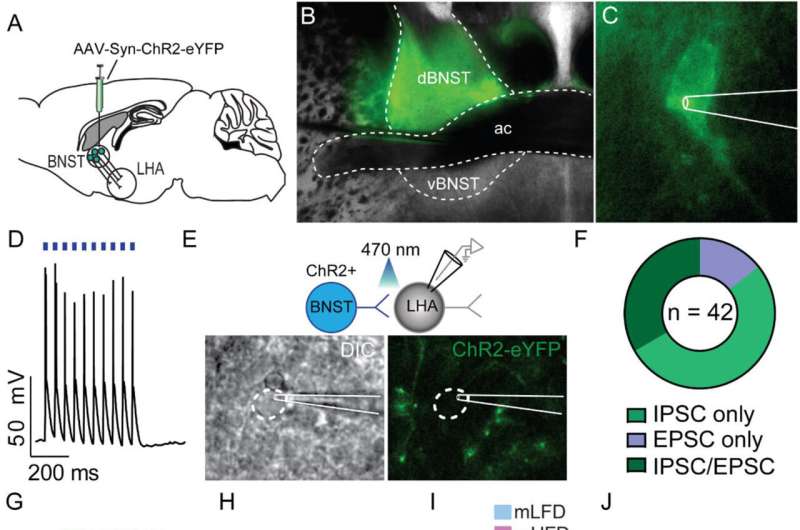BNST→LHA connectivity is primarily GABAergic and is negatively correlated with early life growth rate. A. Experimental schematic. AAV-Syn-ChR2-eYFP was injected in BNST. B. Example of ChR2-eYFP expression in BNST. C. Whole-cell current clamp recordings were made from BNST:ChR2+ neurons to validate ChR2 functionality. D. Example BNST:ChR2+ neuron spiking in response to 5-ms blue light pulses. E-J. LHA cells were patched and evaluated for synaptic connectivity with BNST. F. Proportion of cells exhibiting IPSCs, EPSCs, or both. G. Example trace showing light evoked IPSCs that are blocked by the addition of the GABAA receptor antagonist, gabazine. H. The amplitude of evoked IPSCs was reduced by gabazine (paired t-test, t (33) = 5.61, p = 3.0e-6). I. Evoked IPSC amplitudes were similar between mHFD and mLFD mice (Welch's t-test: t (18.53) = 0.74, p = 0.47). J. Growth rate of juvenile mice significantly predicted the amplitude of evoked IPSCs onto →BNSTLHA neurons (r = −0.72, p = 0.01). n = 15/21 cells from 5/6 mice per group. Values are individual data points with mean ± sem overlaid. Credit: Molecular Metabolism (2023). DOI: 10.1016/j.molmet.2023.101702
People whose mothers are overweight during pregnancy and nursing may become obese as adults because early overnutrition rewires developing brains to crave unhealthy food, according to a Rutgers study in Molecular Metabolism.
Rutgers researchers traced this link from mother to child in mice with an experiment that began by letting some mice get obese on unlimited high-fat food during pregnancy and breastfeeding while keeping others slim on limitless healthy food. They found that mice born to obese mothers stay slim in adulthood on unlimited healthy food but overeat more than mice born to lean mothers when given access to unhealthy food.
The findings indicate that while people whose mothers were overweight during pregnancy and nursing may struggle to moderate their consumption of treats, they could safely eat their fill of healthy foods.
The study may also help inform the development of brain-altering drugs that reduce cravings for unhealthy food.
"People born to overweight or obese mothers tend to be heavier in adulthood than people born to leaner mothers, and experiments like this suggest that the explanation goes beyond environmental factors such as learning unhealthy eating habits in childhood," said Mark Rossi, a professor of psychiatry at Rutgers Robert Wood Johnson Medical School and senior author of the study.
"Overnutrition during pregnancy and nursing appears to rewire the brains of developing children and, possibly, future generations."
In the experiment, researchers gave the high-fat food to three sister mice and the healthy chow to another three of their sisters. Once breastfeeding was complete, the researchers turned their attention to the nearly 50 pups—who predictably started at heavier or lighter weights, depending on their mom's diet.
Their weights converged (at healthy levels) after all the pups received several weeks of unlimited healthy chow, but they diverged again when the researchers offered them constant access to the high-fat diet. All the mice overate, but the offspring of overweight mothers overate significantly more than the others.
Further analysis indicated that the differing behaviors probably stemmed from differing connections between two parts of the brain—the hypothalamus and the amygdala—that arose because of differing maternal nutrition during pregnancy and breastfeeding.
The study has mixed implications for people born to overweight mothers who struggle with their own weight. On the one hand, it suggests the possibility of staying lean while eating healthy food to satiety and avoiding junk entirely. On the other hand, it suggests that efforts to eat moderate quantities of unhealthy treats may spur overconsumption and obesity.
Looking forward, the study's finding about disrupted brain circuits in the two groups of mice may help inform the creation of drugs that would block the excess desire to consume unhealthy foods.
"There's still more work to do because we don't yet fully understand how these changes are happening, even in mice," Rossi said. "But each experiment tells us a little more, and each little bit we learn about the processes that drive overeating may uncover a strategy for potential therapies."
More information: Kuldeep Shrivastava et al, Maternal overnutrition is associated with altered synaptic input to lateral hypothalamic area, Molecular Metabolism (2023). DOI: 10.1016/j.molmet.2023.101702
Journal information: Molecular Metabolism
Provided by Rutgers University
























